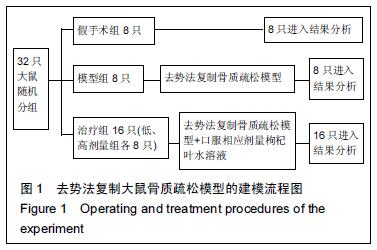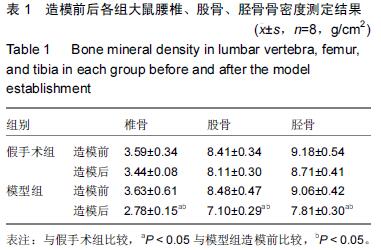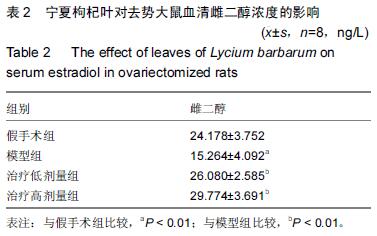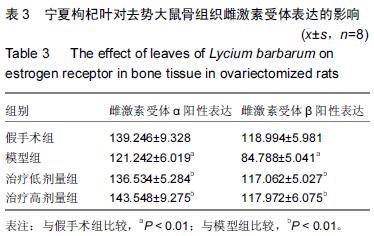中国组织工程研究 ›› 2016, Vol. 20 ›› Issue (15): 2178-2183.doi: 10.3969/j.issn.2095-4344.2016.15.007
• 组织构建基础实验 basic experiments in tissue construction • 上一篇 下一篇
宁夏枸杞叶对去势模型大鼠雌激素受体表达的影响
马 锋,马敬祖,巩 凡,高 俊,吕金悍
- 宁夏回族自治区人民医院骨科,宁夏回族自治区银川市 750021
Effects of leaves of Lycium barbarum on estrogen receptor in ovariectomized rats
Ma Feng, Ma Jing-zu, Gong Fan, Gao Jun, Lv Jin-han
- Department of Orthopedics, Ningxia People’s Hospital, Yinchuan 750021, Ningxia Hui Autonomous Region, China
摘要:
文章快速阅读:
.jpg)
文题释义:
枸杞:枸杞是茄科植物,人们日常食用和药用的枸杞子多为宁夏枸杞的果实“枸杞子”,而且宁夏枸杞是唯一载入《2010年版中国药典》的品种,与琼珍灵芝、长白山人参,东阿阿胶并称为中药四宝。宁夏枸杞在中国栽培面积最大,主要分布在中国西北地区,而其他地区常见的为中华枸杞及其变种。
激素受体:是一种蛋白质分子,它们较多地存在于靶器官的细胞内,可与激素发生特异性结合而形成激素-受体复合物,使激素发挥其生物学效应。
背景:前期实验发现枸杞叶主要成分枸杞多糖对成年去势雌性大鼠骨质疏松有明显的骨质改善作用。
目的:观察宁夏枸杞叶对去势大鼠血清雌激素和骨组织雌激素受体表达的影响。
方法:SD雌性未孕6月龄大鼠32只,分为3组。模型组和治疗组切除大鼠卵巢建立绝经后骨质疏松症动物模型。假手术组仅切除卵巢周围少许脂肪组织立即关闭切口。造模后8周后治疗组大鼠随机分为2组,分别饮水服枸杞叶500 mg/kg(治疗低剂量组)和枸杞叶1 000 mg/kg(治疗高剂量组),每天1次,连续12周;模型组和假手术组给予等量的蒸馏水。用放射免疫法(RIA法)检测大鼠血清中的雌二醇的水平变化,运用免疫组织化学方法检测雌性大鼠各组骨组织中雌激素受体的变化。
结果与结论:与假手术组比较,模型组大鼠血清雌二醇明显降低(P < 0.01);与模型组比较,药物治疗组可以明显提高血清雌二醇浓度(P < 0.01),高剂量组明显。与假手术组比较,模型组大鼠血清雌激素受体α、雌激素受体β明显降低(P < 0.01),模型组比较,治疗组雌激素受体α、雌激素受体β表达量增加,差异有显著性意义(P < 0.01)。结果说明,宁夏枸杞叶能提高去卵巢骨质疏松模型大鼠血清雌二醇水平和骨细胞雌激素受体α、雌激素受体β的表达,可能是治疗骨质疏松症的重要机制。
中国组织工程研究杂志出版内容重点:组织构建;骨细胞;软骨细胞;细胞培养;成纤维细胞;血管内皮细胞;骨质疏松;组织工程 ORCID:0000-0002-4333-9616(马锋)




.jpg)